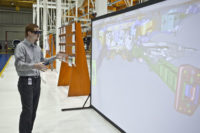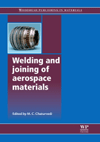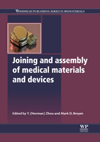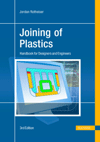
Installed SpotFast fastener used as a single, flush-mounted pivot joint that is joining dissimilar metals, in this case, brass and steel.
When an application requires two thin metal sheets to be joined permanently face-to-face, designers routinely have turned to rivets, welding, or adhesives and tapes. But tradeoffs loom with each of these methods. An innovative fastener design using clinch technology provides a more practical and less complicated joining method that is able to perform multiple functions and expand design possibilities.
Appliance-related applications abound for connecting thin metal sections. Examples include HVAC ductwork, fan-blade assemblies, foodservice equipment, vending machines, ATMs, change machines, disk-drive holders, security metal detectors, nameplates or maintenance instructions attached to appliances or enclosures, and many others.
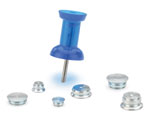
SpotFast fasteners shown in various sizes.
Riveting can work more effectively for attaching dissimilar thin materials, but rivets cannot install flush with a finished surface. Rivets leave unsightly metal bulges, often limiting their use to utilitarian assembly inside enclosures. Since rivets do not finish flush, attention must further be paid to the clearance necessary for the rivet bulb. The bulb can rob valuable "real estate," especially in applications where space is at a premium.
Adhesives and tapes fulfill requirements for clean and flush attachments, but their downside is a relative lack of strength compared with mechanical joining methods. Users quickly discover that epoxies can be messy; double-sided tapes can be cumbersome; and tapes and adhesives can fail when exposed to extreme heat.
A recently developed, patented clinch fastener sheds all this baggage and effectively permits two metal sections to be joined permanently and flush to create a smooth-finish surface. Users can marry two dissimilar metal types and join sheets of unequal thickness.
An added advantage: The fasteners can perform as flush-mounted hinges or pivot points, whereby the top sheet rotates around the fastener while the bottom sheet remains stationary.

Demonstration of how a SpotFast fastener installs smoothly with the top panel.
Solution by design
The original mission for the PEM SpotFast fastener was simply to apply clinching technology to fasten two sheets of metal together (much like a spot weld). Two separate clinch profiles with separate undercuts (top and bottom) were incorporated in the design.It then became apparent during development that the fastener would best install from one side instead of between the two sheets; otherwise, additional fasteners could not be installed. Installation from the top side and the fastener's profile also would provide a capability for automatic installation and rapid assembly of parts in high-volume applications.
Installation from the top subsequently led to a need for a relatively larger installation hole in the top panel. In this way the top panel becomes captured between the head of the fastener and the bottom sheet. This yielded an opportunity to engineer a loose clinch on the top sheet, enabling the top metal section to rotate without affecting the integrity or holding power of the bottom clinch.
The challenge of concentricity between the holes at the time of assembly is met by controlling the volume of metal pushed into the fastener's respective undercuts.
During installation, overfilling the bottom undercut ensures that the bottom sheet remains stationary and accommodates greater tolerance on the diameter of the hole to permit slight eccentricity. The top undercut is under-filled during installation to permit rotation of the top sheet. The tapered top portion of the fastener ensures that the top sheet will pivot with no loose clearance after installation.
No special equipment is required to install these fasteners beyond a standard press. Using flat punch and anvil, a press squeezes the fastener into place and causes displaced sheet material (which is softer than the fastener) to cold-flow into the two clinch profiles and lock the fastener in place.

SpotFast fastener installed sub-flush with the second panel.
Smooth and flush
SpotFast hardware has been engineered to install smooth with the top sheet and flush or sub-flush with the bottom sheet. Since the fastener installs flush with the surface, it can be concealed with paints, powder coatings, or otherwise finished without marring an assembly's surface.One of the primary advantages of clinch technology is that unlike rivets or similar hardware, clinch fasteners do not deform during installation. They are harder than the host material. As a result, none of the appearance or clearance problems associated with rivets will be experienced.
Clinch hardware is relatively harder than rivets, too, delivering greater shear strength for the same diameter in an application.
Standard parts in the SpotFast product line are made from zinc-plated steel. Aluminum fasteners can also be manufactured and anodized to match. Stainless SpotFast hardware made from a precipitation hardenable alloy can be ordered for use in stainless-steel appliances. Designers should keep in mind that the fastener must be harder than the host stainless-steel sheet in order for the sheet material to displace and for effective clinching to occur.
SpotFast fasteners can install in sheets as thin as 0.030 in./0.8 mm and, if the minimum thickness requirement for the bottom sheet is satisfied, it can be thicker. They can also be installed blind in the second sheet (with counter-bore hole provided).
In terms of joint design, the only significant requirement is that the top sheet have a larger diameter hole than the bottom sheet. Additionally, with sheets of different thicknesses, it is generally preferable for the top sheet to be the thinner one.
If the assembly is a pivoting application, a washer of any type can be added between the sheets for the purpose of adding friction, relieving friction, or adding space between the sheets so that they don't rub against each other.
As with many new designs, the original very often will suggest variations, based on specific application requirements or evolving customer needs.
In this case, for example, locating a spring between the two metal sections could serve to generate friction and allow for especially precise control of the pivot. This concept has joined many others on the drawing board. And an alternate version of SpotFast hardware already has been developed with a broaching section ideally suited for metal-to-plastic attachment applications.
